pH_Meter A pH meter is an electronic instrument used to measure the pH (acidity or alkalinity) of a liquid (though special probes are sometimes used to measure the pH of semi-solid substances). A typical pH meter consists of a special measuring probe (a glass electrode) connected to an electronic meter that measures and displays the pH reading.THE PROBEThe pH probe measures pH as the activity of hydrogen ions surrounding a thin-walled glass bulb at its tip. The probe produces a small voltage (about 0.06 volt per pH unit) that is measured and displayed as pH units by the meter. For more information about pH probes, see glass electrode.THE METERThe meter circuit is no more than a voltmeter that displays measurements in pH units instead of volts. The input impedance of the meter must be very high because of the high resistance — approximately 20 to 1000 MΩ — of the glass electrode probes typically used with pH meters. The circuit of a simple pH meter usually consists of operational amplifiers in an inverting configuration, with a total voltage gain of about -17. The inverting amplifier converts the small voltage produced by the probe (+0.059 volt/pH) into pH units, which are then offset by seven volts to give a reading on the pH scale. For example: At neutral pH (pH 7) the voltage at the probe's output is 0 volts. 0 * 17 + 7 = 7. At basic pH, the voltage at the probe's output ranges from +0 to +0.41 volts (7 * 0.059 = 0.41). So for a sample of pH 10 (3 pH units above neutral), 3 * 0.059 = 0.18 volts), the output of the meter's amplifier is 0.18 * 17 + 7 = 10. At acid pH, the voltage at the probe's output ranges from -0.41 volts to -0. So for a sample of pH 4 (3 pH units below neutral), -3 * 0.059 = -0.18 volts, the output of the meter's amplifier is -0.18 * 17 + 7 = 4. The two basic adjustments performed at calibration (see below) set the gain and offset of the inverting amplifier.CALIBRATION AND USE For very precise work the pH meter should be calibrated before each measurement. For normal use calibration should be performed at the beginning of each day. The reason for this is that the glass electrode does not give a reproducible e.m.f. over longer periods of time. Calibration should be performed with at least two standard buffer solutions that span the range of pH values to be measured. For general purposes buffers at pH 4 and pH 10 are acceptable. The pH meter has one control (calibrate) to set the meter reading equal to the value of the first standard buffer and a second control (slope) which is used to adjust the meter reading to the value of the second buffer. A third control allows the temperature to be set. Standard buffer sachets, which can be obtained from a variety of suppliers, usually state how the buffer value changes with temperature. The calibration process correlates the voltage produced by the probe (approximately 0.06 volts per pH unit) with the pH scale. After each single measurement, the probe is rinsed with distilled water or deionized water to remove any traces of the solution being measured, blotted with a clean tissue to absorb any remaining water which could dilute the sample and thus alter the reading, and then quickly immersed in another solution. When not in use, the probe tip must be kept wet at all times. It is typically kept immersed in an acidic solution of around pH 3.0. In an emergency, acidified tap water can be used, but distilled or deionised water must never be used for longer-term probe storage as the relatively ionless water "sucks" ions out of the probe through diffusion, which degrades it. Occasionally (about once a month), the probe may be cleaned using pH-electrode cleaning solution; generally a 0.1 M solution of Hydrochloric Acid (HCl) is used , having a pH of about one. TYPES OF pH METERSpH meters range from simple and inexpensive pen-like devices to complex and expensive laboratory instruments with computer interfaces and several inputs for indicator ( ion- sensitive, redox), reference electrodes, and temperature sensors such as thermoresistors or thermocouples. Cheaper models sometimes require that temperature measurements be entered to adjust for the slight variation in pH caused by temperature. Specialty meters and probes are available for use in special applications, harsh environments, etc. Pocket pH meters are readily available today for a few tens of dollars that automatically compensate for temperature (ATC, Automatic Temperature Compensation)

This is Great Information...
ReplyDeleteThanks for Sharing...
pH Meter, Data Logger, Temperaturer Logger, Humidity Meter, Controller